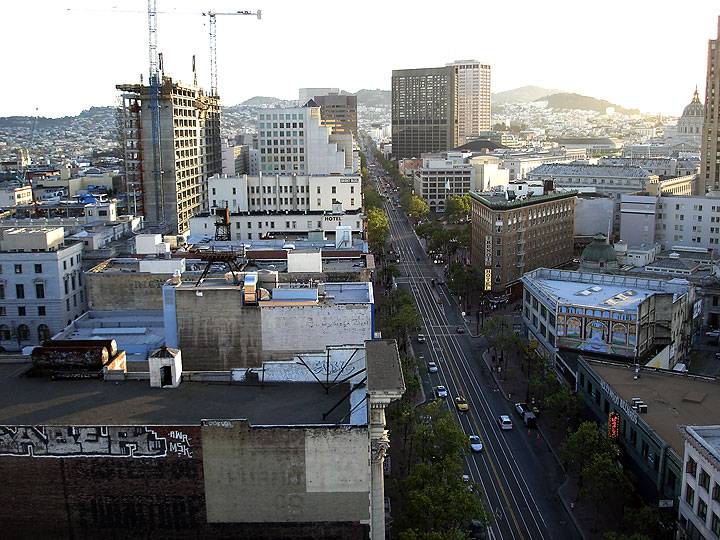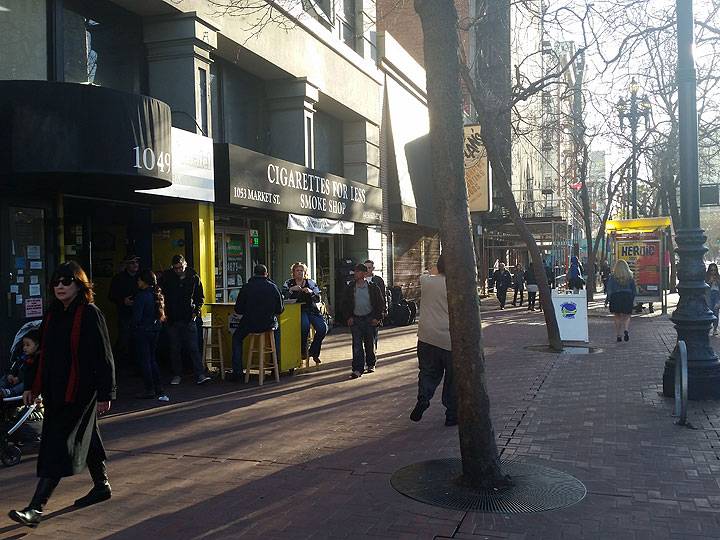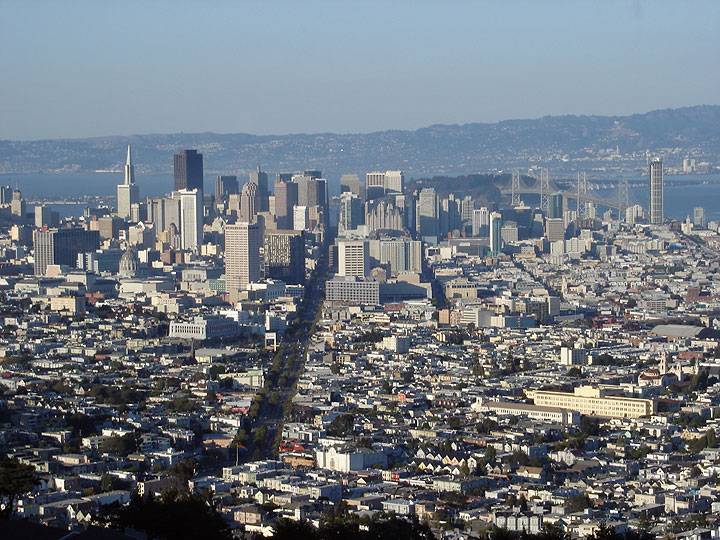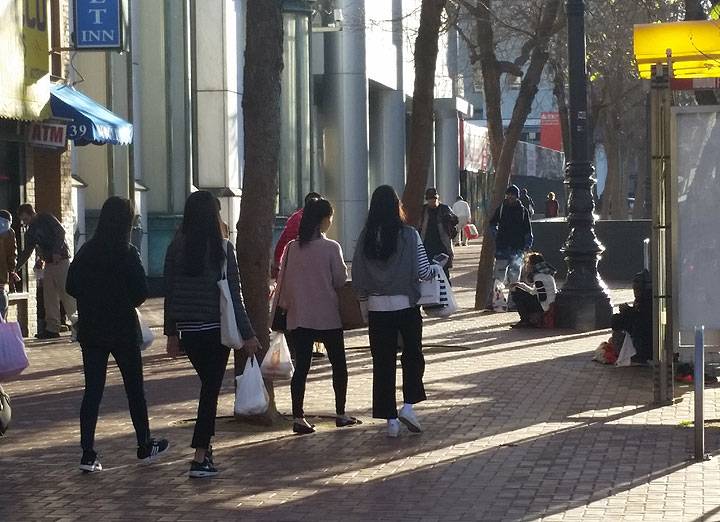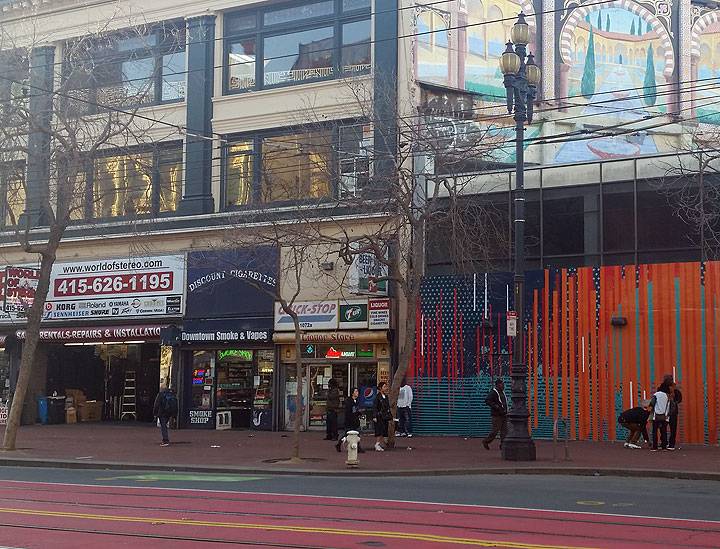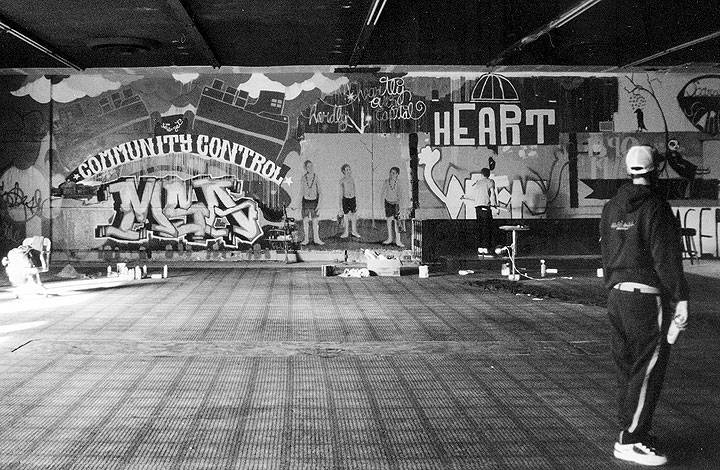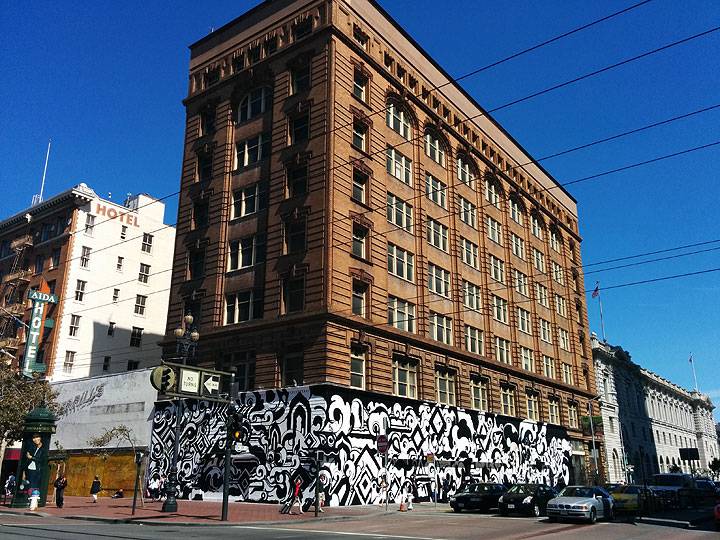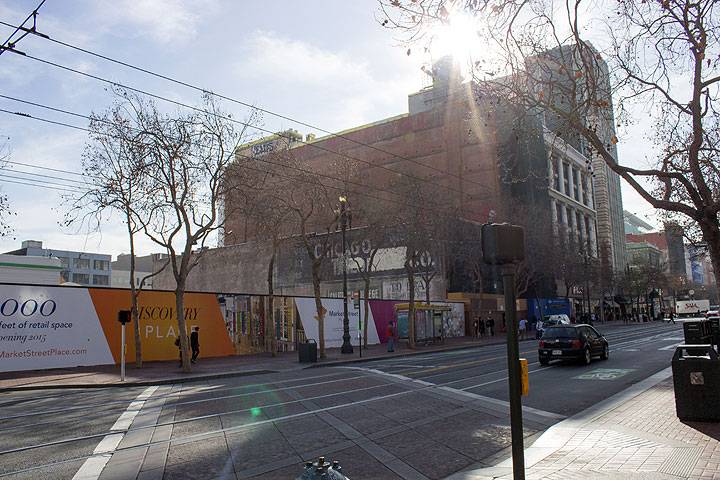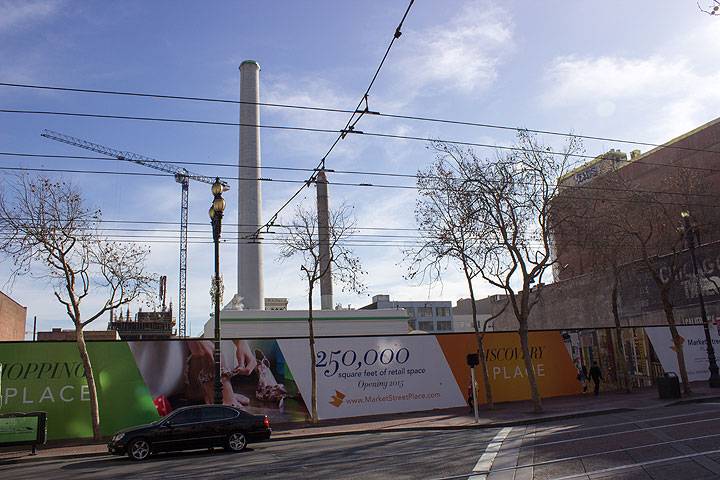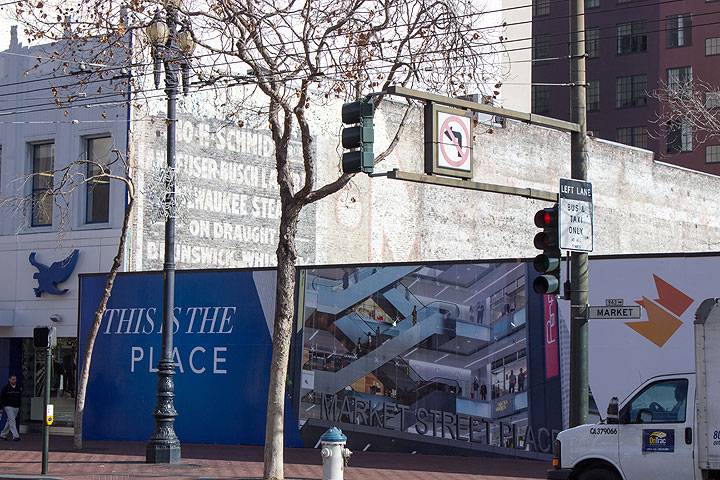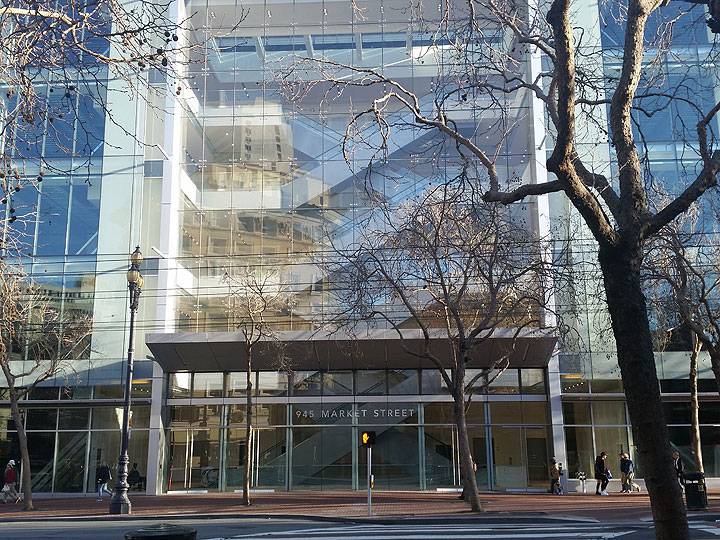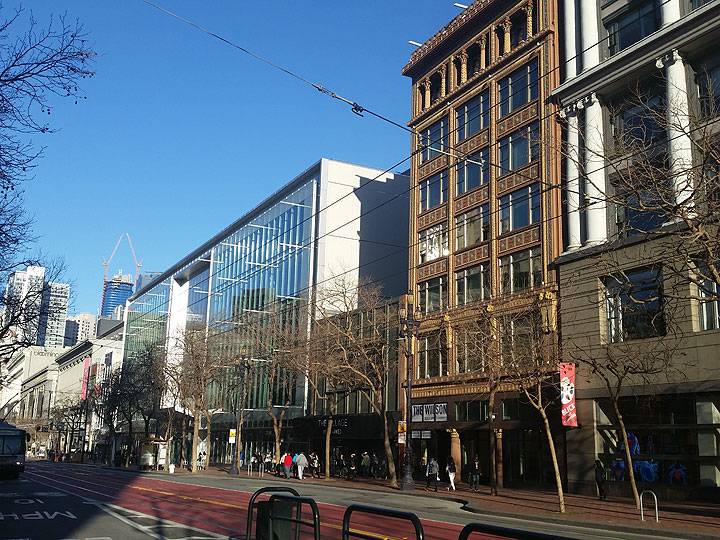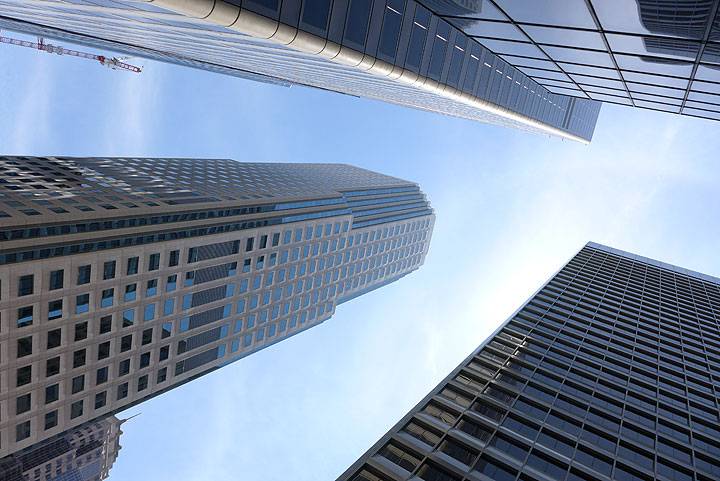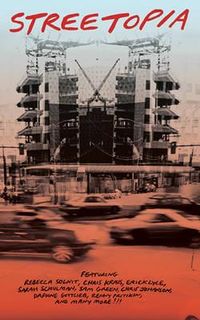Uses of Market Street
Historical Essay
by Erica Dawn Lyle
Westerly view from Hewes Building at 6th and Market, 2005.
Photo: Chris Carlsson
To walk down Market Street today is to find oneself slipping in and out of time. Here, the great speedup of our digital era meets the medieval as one encounters a vast population of homeless people, many of them sleeping nightly on the streets in front of empty buildings that have been vacant for decades.
The clear-eyed flaneur on Market Street might well conclude that civil society has at last broken down completely. Yet the gritty reality of the street has lately become indistinct, difficult to bring into focus. What once may have been understood as a humanitarian crisis has been rebranded as “The Tenderloin Arts District.” Hallucinations of luxury hotels and shopping malls crowd the street as the past slowly dissolves into the future.
Typical scene along the 1000 block of Market Street's south side, February 2017.
Photo: Chris Carlsson
Conservative mayoral candidates and newspaper publishers with their perennial calls to “Clean Up Market Street” appeal to nostalgia for a kind of civic consensus that in real life has never truly existed. Indeed, the cable car slot in the center of Market Street was for generations seen as a literal border between the upper classes from the hills north of Market Street and the poor homesteaders on the flats “South of The Slot.” I wonder if it is accurate after all to say that there is a city comprised of these competing realities, these alternative futures, so much as it is to say that there are only these alternative futures, and that the place where they stage their perpetual battle is what we call the city. Either way it is certain that Market Street has never really been a “Main Street” for everyone so much as the border where San Francisco’s competing realities collide.
Perhaps no writer has made greater use of the San Francisco’s embrace of alternative futures than Philip K. Dick. His 1962 novel, The Man in the High Castle is a mind-bending masterpiece, set in the parallel universe of fascist San Francisco, fifteen years after the Nazis and Japanese have won World War II. Midway through the book, Dick introduces a book within the book—a popular novel, banned by the Nazi authorities, though widely read in secret in the conquered USA—in which a mysterious author has conjured up a fantasy alternative world. In this underground novel, the United States and England persevered to defeat the Axis Powers. As characters read the banned book, they become unstuck in time, wandering in uncertainty between competing realities.
Dick’s novels are often set in a San Francisco of the future, a familiar city made strange to us by technology and the passage of time. While on the surface they appear greatly changed, Dick locates within these futuristic cities something deep and true about San Francisco—a city sometimes comforted and sometimes haunted by but always in turmoil with its own competing realities.
Putting a Boulevard Through the Dunes
A couple of years before the discovery of gold near Sacramento in 1849 would bring thousands of new settlers to the area, San Francisco was still Yerba Buena, a tiny hamlet of around five hundred people, centered around today’s Chinatown area. A young Irish civil service engineer named Jasper O’Farrell was hired by the military mayor to plot a grid of streets for a future city. O’Farrell, situating his street plan further to the north of the actual settlement, drew a diagonal line from the waterfront directly west toward Twin Peaks and called it Market Street.
The Market Street that O’Farrell proposed for the virtually uninhabited settlement was an incredible 120 feet wide—a full twenty feet wider than its namesake back east in Philadelphia. The proposed right-of-way of this grand boulevard, however, was blocked by a sixty-foot tall sand dune roughly at the site of today’s Palace Hotel. Miles of sand, including dunes reaching ninety feet tall, stretched further west in the future street’s path toward the ocean.
O’Farrell, with his arbitrary line, would thus mark the debut of the concept of “Market Street”—the idea that the future city, not even yet named San Francisco, must be built around a grand boulevard, suitable for both military parades and shopping trips. Property owners, who felt O’Farrell’s future main street would infringe on their land, organized a lynch mob, and O’Farrell fled the Bay Area, never to return. But his grand Market Street was built across the sands anyway. San Francisco has been trying to figure out what to do with it ever since.
Market Street cutting through the city, as seen from Twin Peaks, 2007.
Photo: Chris Carlsson
Perhaps Market Street has never quite been a main street for the San Francisco we see today because the street was not built to scale with the rest of the city, but instead to the specifications of a lost imaginary San Francisco. This ghost city—planned and mapped and deeply longed for, but never built—has always closely shadowed the actual city. Market Street, and San Francisco’s similarly outsized City Hall, can be seen as strange archaeological relics of that lost city that survive today, as if unstuck in time, from some parallel San Francisco in which the Nazis won the war.
By the time the nineteenth century drew to a close, San Francisco was the largest city on the west coast, swollen with money and plunder from the gold fields of the Sierra Nevada and the silver mines of the Comstock Lode in Nevada. City leaders often compared the city to ancient Rome, and war veterans and military bands frequently paraded down Market Street in imperial style. When the United States annexed California from Mexico, city leaders positioned San Francisco as the capital city of what they saw as the inevitable onward flow of manifest destiny across the Pacific. The president of the San Francisco Chamber of Commerce declared, “The nation that shall control the business of Asia will control the world.”
In 1898, a mysterious onboard explosion sank the US battleship Maine in the Havana harbor in Cuba. Though we now know that the explosion was caused by a faulty boiler that blew up, Western capitalists and politicians saw in the flames a perfect opportunity for imperialist expansion. William Randolph Hearst’s San Francisco Examiner inflamed public opinion in favor of a war with Spain. The quick military victories over Spain in Havana and Manila gave the United States its first colonial possessions—Cuba, Puerto Rico, and the Philippines. Even as reports began to spread of US soldiers torturing captured Filipino guerrillas in jungle concentration camps, San Francisco Mayor James D. Phelan erected the Dewey Monument in Union Square to commemorate Commodore Dewey’s handy capture of Manila Bay. The monument depicted the winged Goddess Victory, facing west into the Pacific.
Mayor Phelan and other leaders imagined that with US seizure of the Philippines and more interventions sure to follow, the city would at last fulfill its Roman destiny. Accordingly, architect Daniel Burnham announced a plan to redesign the city along the lines of Baron Haussmann’s redesign of Paris under Napoleon III, cutting many new and grand Market Street-style boulevards through the city and extending Panhandle Park down to City Hall. Historian Grey Brechin, in his book Imperial San Francisco, describes how Burnham’s proposals exemplified the era’s hubris:
“San Francisco’s cheap frame structures would be gradually replaced with monumental buildings of masonry. One-third of the city’s area should be devoted to parks serving an anticipated population of 2 million, while prominent hilltops would be given to monuments honoring the pioneers. Phelan’s projected aqueduct from Hetch Hetchy Valley would eliminate past restrictions on greenery, feeding lawns, and fountains worthy of Versailles… A colossus representing San Francisco would gaze west from Twin Peaks to the city’s future in the Pacific, while an immense drill ground inside Golden Gate Park would permit tens of thousands of civilians to cheer the precision movement of troops and warships on review.”
Instead, a few short years later, the city planner’s imperial dreams would be reduced to rubble. The Great 1906 Earthquake and subsequent fire leveled 4.7 square miles, or 508 city blocks, while destroying 28,188 structures, including City Hall, the Hall of Justice, the Hall of Records, the County Jail, the Main Library, five police stations, and over forty schools.
Following the quake, an epic beaux arts City Hall was built according to Burnham’s plans. Its dome, encrusted with twenty-four karat gold leaf, is still the fifth-largest in the world, a full forty-two feet taller than the US Capitol Building. But Burnham’s other plans for a Roman San Francisco were abandoned in the haste to rebuild a functional city. The city’s population eventually topped out near eight hundred thousand, where it remained for decades, and Los Angeles surpassed San Francisco as the economically dominant metropolis on the west coast.
Post-earthquake San Francisco was like a city that had lost a war. In the famous opening rooftop chase scenes of Hitchcock’s Vertigo, one sees that as late as 1958 a camera could still pan across a San Francisco skyline that featured no skyscrapers.
Today, Burnham’s City Hall, as if beached in the river of time, presides over a city that never realized its early imperial aspirations. The baroque interior now appears charmingly gaudy and decadent, with its gold leaf and marble, its chandeliers and ornate lampposts, and its grand, theatrical staircase. In events that might as well take place in a parallel universe from that the city’s founders imagined, City Hall would reveal what seemed like its fabulous décor’s true purpose all along—in 2004, the area under its rotunda became the perfect setting for the first legally performed gay marriages in the United States.
Skid Row by Design
In her famous early work, The Bowery in Two Inadequate Descriptive Systems, Martha Rosler examined, among other things, the very idea of “skid row.” The work consisted of a series of photographs Rosler had taken while walking along perhaps the world’s most famous such street, The Bowery in New York City. The collection does not include the photos of homeless men one might expect; instead it includes an inventory of their detritus—empty wine bottles, old shoes, crumpled litter. The photos were mounted alongside photographs of words typed on white paper — synonyms for drunkenness like “sodden,” “soused,” “sloshed,” and so on. Rosler’s refusal to present the usual human figures of documentary photography questions photography’s system of representation itself and suggests that such studies might actually perpetuate society’s power structures.
By challenging the representation of The Bowery, Rosler suggests that “Skid Row” — like “Main Street” — is itself a construct. San Francisco redevelopment forces have cynically promoted and manipulated these two twin fantasies of Market Street for generations, forever invoking fears of a nostalgiac “main street” always threatened by an out of control “skid row” in an effort to consolidate their power in the city. Indeed, as the success of the SFRA efforts to remake San Francisco as a city of the rich has led to exorbitant rents and the loss of living wage jobs, the very architects of this transformation point to the subsequent proliferation of homelessness in tourist and business areas agendas as evidence of the progressive left’s inability to govern. While this strategy has again and again elected the more conservative candidate to the mayor’s office, all observers agree that it has not made a dent in the actual homelessness crisis in the Bay Area over the last twenty-five years.
But to solve the problem is not their goal. If it were, building affordable housing and putting a stop to illegal evictions would be a priority. Instead, as the city gives more tax breaks to corporations and green lights the construction of one massive luxury apartment tower after another, each successive mayor simply uses the police to move the homeless encampments strategically around town, keeping them out of sight of the new zones of development and property-value boom. The problem is always said to be improving — except when it isn’t. At election time, homelessness inevitably becomes a crisis again, more evidence of how the permissive Left has allowed the city to disintegrate out of control.
South side of Market, across from UN Plaza near the BART stairwell, February 2017.
Photo: Chris Carlsson
Nearly abandoned area on north side of Market in 1000 block, it used to teem with hustlers and homeless, and sometimes still does.
Photo: Chris Carlsson, February 2017
After living for almost a decade on Market Street and in the Tenderloin, I can only agree that Market Street is a broken or failed civic space. But my proximity also allowed me to see, up close, the ways conservative politicians and property owners manipulated and indeed perpetuated that situation for their own gain. While the crisis of “what to do with Market Street” is a real one, it has also been—like the city’s homeless problem—heavily stage-managed.
949 Market Street
In early 2001, I was among a group of artists and activists who created an arts venue and community space in an illegally occupied abandoned pool hall at 949 Market. Our group had been fighting the displacement and gentrification of the early dot-com boom era in a losing battle for years and had grown weary of picketing the offices of sinister landlords and crashing Board of Supervisors meetings. We wanted to do an action that was more utopian in spirit. With a rallying cry of “What are we FOR, not what we’re against,” we broke into the building, changed the locks, and began fixing up the place in hopes of hosting an enormous public art and performance event.
In that era, with its tremendous scarcity of affordable space, the incredible abundance of unused space in that building—and indeed all over that part of Market Street—was astonishing. When people entered for the first time, I would watch their jaws drop as they took it all in—a completely empty space, almost a block long, with floor-to-ceiling windows overlooking Market. After researching the place, we found it had once been a twenty-four-hour pool hall but had been shuttered and unused for thirteen years. We spent a month cleaning up thick layers of dust, fixing the plumbing and getting the electricity in order, while dreaming up the kinds of events we could do in that kind of wide-open space.
Interior of 949 Market during its thriving months as a free space.
Photo: Erick Lyle
Ultimately, a group of artists collaborated on a series of floor-to-ceiling murals that flowed in and out of each other around the perimeter of the entire room, while the rest of us scavenged materials from the abandoned movie theater next door and built a mini-theater in one corner. On opening night, March 30, 2001, five hundred or so people came to eat an enormous buffet of free food and check out a program of bands, speakers, movies, and art installations arranged around the enormous room. The event was a huge success. For our immediate community it was a historic assertion of how much we could actually accomplish together in a time when little had previously felt possible for years.
Now that we had succeeded, we found ourselves in the unexpected role of being the curators and administrators for perhaps the largest independent art venue in the city. In the months that followed, 949 Market would host ongoing tours of the murals, all night dance parties, punk shows, film festivals, and even the production of a queer porno movie. We started doing a Sunday Free Café—inspiration for the Streetopia Free Café—where coffee, bagels, fruit, and newspapers were provided for a diverse crowd of Mission artists and activists and Market Street homeless. A month after the first event, a couple of us in the core group—myself included—finally moved into 949 Market and started living there.
Ironically, this underground arts renaissance on Market took place simultaneously with one of the most virulent “Clean up Market Street” campaigns in recent memory. Local newspaper publisher, Ted Fang, had just purchased the nearly moribund afternoon daily, The San Francisco Examiner, and established its new offices in The Warfield Building at Sixth and Market—almost directly across the street from 949. Fang also bought the Warfield Building and immediately relaunched the paper in tabloid form, with nearly every day’s front page devoted to a series called “The Mess on Market.”
The Examiner proclaimed Market Street a wasteland populated by zombie addicts, likening the human residents of Sixth Street each day to garbage or animals in bullet point type. Sensational and lurid stories breathlessly detailed incidents of petty violence, drug dealing, or even of public urination outside The Warfield’s door. Never before has so much ink been spilled nor so many reporters deployed to publicly describe scattered bits of human feces found in Mid-Market alleys. As Hearst’s Examiner once drummed up a public hysteria to promote a war with Spain, the new tabloid declared its own war on Mid-Market citizens, calling for more police on the street, the closing of SRO hotels, and even, memorably, the demolition of the entire neighborhood to build a stadium that might be used to lure the Olympics to San Francisco. Anyone could see that the once-proud “Monarch of the Dailies” was now merely a cynical front to raise the value of Fang’s property in the area. But Fang’s Examiner made enough noise that local TV and even the Chronicle started to pick up the drumbeat.
Which is how it came to be that I was sitting in the squat one morning, drinking coffee, when I unfolded that day’s Chronicle to find an enormous photo of the roll-down door that covered the entrance to 949 Market on the cover of the local section. The photo accompanied a long article about the decline of the Mid-Market Street area, and though written in a somewhat more even-handed tone than that of the Examiner, it nonetheless echoed the accepted truths that the abundant homeless, welfare hotels, and soup kitchens of the area were preventing property owners from finding tenants for their unused and empty spaces.
The article quoted various sources bemoaning the impossibility of bringing arts organizations, cultural events, community uplift, or affordable housing to the area until the offending blight had been removed. I could not stop laughing; behind that very door in the photo was a space that had, in a short time, brought all of those things and more directly to Market Street without spending a dime!
After about four months, the space was accidently discovered by maintenance workers employed by the owner, resulting in an unceremonious eviction. In the process, we learned that the owner of 949 Market was none other than Bob Lurie, the scion of a prominent San Francisco real estate family and former owner of Major League Baseball’s San Francisco Giants. Though fabulously wealthy, Lurie had famously threatened to move the team again and again during the 80s and 90s to either San Jose or Tampa Bay if the city’s taxpayers did not approve a publicly funded new stadium for the team. Lurie lost two ballot measures on the issue and finally sold the team at a windfall profit, but he knew how to play hardball with his other properties, too. The squat’s murals were painted over the day after the eviction, and the enormous space at 949 Market would then remain empty and completely unused – except by the homeless who continued to sleep in front of the roll down door from the Chronicle photo – for the next 12 years.
In the years to follow, I would continue to work with many from the 949 Market group in efforts to find a rental space where we could realize our visions for the kind of community arts space that we had briefly achieved at the squat. Through fundraising and a sizable donation of seed money from a benefactor, the group amassed a substantial amount of money for a potential rental. Yet, again and again, we found that the countless long-vacant properties throughout the Tenderloin and Mid-Market areas were only nominally available.
While many vacancies had “For Rent” signs posted, landlords and real estate agents would not return calls, numbers were not in service, or landlords were asking for rents double what people were already paying in the area. It became clear that these properties were being deliberately held vacant so the owners could receive tax write-offs on their supposedly unrentable properties. They had no intention of renting to anyone other than a top dollar chain store—unless perhaps they could hold out long enough to be bought out by the SFRA, who had established an official Mid-Market Street Redevelopment Zone in 1995.
The Grant Building at 7th and Market, abandoned and before it's rehabilitation into a hotel.
Photo: Chris Carlsson, 2014.
This common Market Street landlord strategy was later outlined in great detail by developer David Rhoades in an interview with online news site SFPublicPress.org in 2010. Rhoades cofounded the commercial real estate business Urban Realty, and—backed by a $40 billion Connecticut-based lender, Commonfund—bought 949 Market from Lurie in 2006, while also quietly buying up many of the surrounding buildings. At the time of the interview, Rhoades owned ten buildings in the area—including sixty-two percent of the square footage between Fifth and Sixth Streets on Market. In the article, Rhoades bragged how he had become the major property owner in the Mid-Market area by using a variety of shell limited liability companies and that he had no intention of leasing out any of his properties until he could get the maximum potential profit from all of them at once.
“We’re waiting for the area to start to really pop,” he told the site. “Then we can get someone in that’s much higher-end.”
In London, another high-cost “world-class” city, the municipal government decided in recent years to end tax relief on storefront and retail spaces that are left unrented for longer than six months in an effort to discourage just this sort-of deliberate vacancy and speculation. But San Francisco’s Gold Rush values still shine through in the real estate speculation that has hollowed out Market Street for decades. By withholding needed space, the property owners have created the very derelict conditions that they decry, while cynically blaming these conditions on those who have the very least power to affect the situation—the homeless themselves.
While those calling for the Market Street clean up over the years repeatedly talk about how the city’s main drag needs arts, culture, or residential development, Rhoades and Urban Realty got the go ahead to build instead a 260,000 square foot mall to be called City Place between 935 and 961 Market Street. In search of a master tenant to anchor the new development, Rhoades began discussions with chain retailers like Nordstrom Rack and Bed, Bath, and Beyond. Rhoades had done his bragging too soon. Before area residents had time to contemplate the bait and switch that had somehow conflated their hopes for a better neighborhood with the success of a new towel and sheet store, the financial backer of the project, Commonfund, went bankrupt and Urban Realty’s Market Street properties went into foreclosure. San Francisco government and citizens alike were now powerless to do anything to affect change at the site. Eventually the property was bought by a Dallas-based private equity firm, Lone Star Funds, and the neighborhood could only watch and wait while the new out-of-state corporate owner sat on the properties, waiting for the best possible return on their investment.
Another out-of-state firm, Cypress Equities, bought the properties in 2012 and announced that work would continue on the mall—now to be renamed Market Street Place. The developers cheerfully announced they were courting JC Penney’s to anchor the project—even though the mid-level retailer was actually at that time closing store locations across the country. Soon, negotiations with JC Penney fell through, and Nordstrom Rack had chosen another site. In 2013, the St. Francis Theater, the 949 Market squat, and the other contiguous properties were demolished anyway. A groundbreaking ceremony for Market Street Place was held in November 2014 with Mayor Ed Lee on hand to toss the first shovel of dirt. As of this writing, the plot is still a hole in the ground, and Cypress is still in search of an anchor tenant for the mall. The firm’s CEO told an interviewer the firm planned “to wait to get it right.”
Former site of 949 Market Street before construction on a new mall had fully begun, January 2014.
Photo: Chris Carlsson
Same place, January 2014.
Photo: Chris Carlsson
Eastern end of cleared property, January 2014.
Photo: Chris Carlsson
Despite the ongoing setbacks with the development, local news and real estate sites continue to trumpet the possible future mall as the long awaited savior of the Mid—Market area – an area already crowded with ailing malls. Indeed, this is hardly the first time a new mall has been heralded as a magic bullet to turn around the depressed downtown area. In 1999, The Metreon, a four-story mall filled with retail space, gaming centers, and a sixteen screen IMAX theater—the first of a proposed chain of Sony “urban entertainment centers”—opened two blocks from 949 market at Fourth and Mission. Projections of six million in foot traffic fell far short and by 2001 major tenants had begun to leave. By 2006 Sony had sold the mall. By 2012, after a series of failed attempts to rebrand The Metreon as a “food-oriented mall” (even briefly featuring a 7-day a week farmer’s market), much of the building was reconfigured as an outlet of the discount chain retail store Target.
Supporters of Market Street Place typically like to frame their argument in absolutes; either you are for “change”—as represented by a gleaming new mall—or you are for the status quo, as represented by Market Street’s sizable homeless population. The case of The Metreon, however, demonstrates that a mall is by no means a certain cure-all to an area’s social ills. Since The Metreon opened four people have been shot inside the mall. In June 2001, when a suicidal and mentally disturbed young African-American man brandished a knife at theater employees, police stormed the darkened IMAX theater, initiating a chaotic shootout in which the man was shot twenty times and an officer was wounded by another policeman’s bullet while a movie played onscreen. It was as if the old Fourth and Mission skid row, seemingly long erased by ’70s-era redevelopment, had bled through the gloss of the mall.
In recent years, San Francisco has adopted laws and strict zoning codes against the proliferation of the kinds of chain stores that will crowd Market Street Place. Planners have for generations envisioned Market Street as the hub of all city public transportation with BART and MUNI and miles of new bicycle lanes. Yet even as a car-free section of Market Street comes closer to reality, Market Street Place—if it’s ever built —will feature a massive underground parking garage for private automobiles. Meanwhile, the owners of the Westfield San Francisco Shopping Center one block away have publicly considered opening a police substation inside the mall to curb the massive amount of shoplifting, and the mayor announces the street will be a dot com corridor.
The former pool hall we squatted at 949 Market went out of business in 1988. The Market Street Place mall is currently scheduled to open in 2016. In the intervening twenty-eight years that prime piece of downtown real estate— just one block away from the crowds of tourists at the Powell Street Cable Car turnaround— has been useless to the public save for our four-month occupation. Instead, the property was sold and resold again and again by local and then out-of-state speculators who held the city’s main street hostage until planners and supervisors were so desperate for anything to happen that they’ve come to champion a project utterly at odds with decades of city planning.
The utopian thinking that led to the 949 Market squat brought hundreds of people together for a four month period in 2001 to stand together in an abandoned building and explore possibilities for what another Market Street might look like. Proponents of Market Street redevelopment and projects like the Market Street Place mall have always dismissed such utopian thinking as unrealistic. But if anything, their attachment to the idea of a magic shopping mall solution reveals just how much redevelopment forces rely on pure fantasy in their own efforts. Market Street Place is currently an enormous hole in the ground. Yet its website features a slick promotional video, complete with drone flyover footage and a lavish computer animated fly-through simulation of the proposed six level center. The plans for Market Street Place are as much an arbitrary work of the imagination as O’Farrell’s original plans for the street itself.
Not yet open, the new mall stands gleaming in the former site of 949 Market, now with the addres 945 Market.
Photo: Chris Carlsson, February 2017
The new mall stands in the middle of the 900 block of Market, surrounded by older more venerable buildings that have recently been refurbished and converted to expensive loft apartments and other uses.
Photo: Chris Carlsson, February 2017
Meanwhile, the computer-generated architectural renderings for shiny, futuristic new buildings to be constructed up and down Market Street depict crowds of pedestrians and cyclists, smiling and enjoying each other’s company on the sidewalks of a fantasy future Market Street. The people in these renderings are like people in a dream — always hazy, semi-transparent, indistinct. It is as if they are in the process of being beamed down from The Future. Yet, the images, fuzzy and blurred, also evoke a nostalgic sense of civic consensus in an urban setting that today we tend to associate with the lost past, the comforting fantasy of Main Street.
The proliferation of these renderings of the future Main Street suggests that the hole in the ground where 949 Market once stood can be seen as a metaphor for something else vital missing from San Francisco today. Many of those who support the proposed mall seem to yearn for the same kind of community and togetherness that my collaborators and I once built together inside the 949 Market squat. I wonder now which is more poignant – that a group of people had to break into an empty building to try to find that togetherness, or that the widespread public longing for community has been again and again cynically manipulated by city government and private developers for their own private gain ever since Market Street itself was just an imaginary line drawn across the sand.
Quality of Life?
While anti-gentrification forces in San Francisco have long identified the high-end and expensive tastes of tech industry workers as a driving force in economic displacement, it would perhaps be better to understand the proliferation of five star restaurants and artisanal boutiques as the visible result of a worldwide top-down reorganization of urban space by capital so as to create these new luxury tastes and the space for their consumption.
In recent years, the phrase “Quality of life” has come to represent not so much a human right but a kind of brand name for the new tastes and desires associated with life in the city today – the fantasy urban life associated with the neo-liberal fulfillment of individual needs through unfettered consumer freedom. Yet, “Quality of Life” appears to us haunted by its own shadow. Images of The Good Life—always just out of reach—trigger inchoate and uncontrollable longings. What happens when the vast majority of a population can’t afford this life or when the few will not share it with the many? In Brazil, thousands of youth rioted for free rides on public transportation. Protesters in Turkey battled police to keep a park in the city center from closing. Occupy Wall Street protesters across the United States demanded an end to student debt. And so on. As we have seen in recent years, in the era of urbanization it is the global street where these qualities are advertised and contested.
This battle – and the loaded term “Quality of Life” -- has come home to San Francisco’s increasingly tense and polarized streets in many forms in recent years. The city relies on the police department to manage the migration and growth of homeless encampments away from tourist districts through the diligent writing of so-called “Quality of Life” citations for such infractions as sleeping or drinking in public. In the past decade, many new local ballot measures and city ordinances have placed severe restrictions on the public behavior of homeless people—most notably the controversial “Sit/Lie” Law which in 2010 made it illegal for anyone to sit down on a public street in the city. Meanwhile, as the police and lawmakers vilify the homeless, protesters stage high-profile protests against the so-called Google Busses—the private fleet of spacious and punctual busses the tech firm uses to shepherd its employees in cocoon-like safety to work and home each day through the city’s increasingly broken-down public spaces.
Richard Russo’s best selling sci-fi detective series of the 1980s, The Carlucci Series, is set in a dystopian San Francisco of the near future in which the Tenderloin, laid waste by rampant addiction and AIDS infection, has been walled off from the rest of the city, its poverty-stricken residents unable to legally leave the area’s streets.. Meanwhile, even a city cop like Carlucci lacks the proper credentials to be allowed into the buffeted Financial District.
Today the conflict found in the streets of San Francisco approaches this level of dystopian science fiction, but with a twist. The very rich and very poor do not live in separate, walled off areas of San Francisco, but instead walk the same streets side by side—only with different abilities to access the city. While some can use their phone to quickly arrange a ride in a private car, a dinner reservation, or even a sexual hookup with a stranger, others cannot even enter most businesses to use a restroom. The simultaneity of virtual commerce and communication has rendered the class border of Market Street invisible. San Francisco residents walk side by side on the new “Main Street,” some held in a protective bubble by privilege and others free to roam the streets forever in their own private ghetto.
Towering highrises have obliterated any memory of a "high-rise revolt."
Photo: Chris Carlsson
Mayor Ed Lee justified the tax breaks he would use to engineer his Market Street “Dot Com Corridor” with claims that the hundreds of new employees of tech firms relocating to the area would soon spend their money at Mid-Market businesses. Yet, when the new Twitter headquarters was completed at Tenth and Market, the company proudly showed off the company cafeteria that had been installed for employees. Like other tech firm campuses in Silicon Valley, it turned out that Twitter’s employees could find not only food but laundry facilities, health care, yoga studios, and even a rooftop garden all on-site. While the company’s presence was supposed to bring street life to Market, the abundant amenities found in the company’s new headquarters, in fact, make any contact with the street and its surrounding people or businesses unnecessary.
Yet, ironically, as the demographics begin to change on gentrifying Market Street, the city -- so concerned just a few years ago with stopping people from sitting and loitering on the street -- is now promoting plans for a Market Street that encourages more people to sit and linger on Market Street. The mock-ups for Better Market Street 2018 include illustrations of segments of the Market Street sidewalk, between fourteen and twenty feet wide, re-engineered to accommodate an informal arrangement of benches and movable chairs and tables nestled within a tiny grove of street vegetation.
While the two thousand Twitter employees who work on Market Street may have limited contact with the street, they would recognize at once in these plans the fabled open plan offices and unconventional work spaces of Silicon Valley relocated outdoors to the Better Market Street of 2018. Indeed, the plans inscribe on the streets the very language of the Internet. The plan refers to these new seating areas as “Streetlife Nodes” — the name for the connection of Internet networks now to be depressingly used as a metaphor for the meetings of human friends on the street. And even more Internet metaphors abound. The Street Nodes are said to be “programmed and laid out to invite for interaction, meetings, information, knowledge sharing, etc.” And so the new Market Street becomes an extension of the dot com office, where project problem solving is said to flow smoothly because there is ample opportunity for employees to decamp to abundant informal meeting spaces or to enjoy a quick snack or casual game of foosball together.
What is perhaps most striking in these plans is their reliance on the reintroduction of so many former elements of the public spaces of the city that have in recent years been greatly restricted or removed. It is as if the titans of the Internet have at last conquered the physical world with their empire of cyber space only to find in despair that what they really wanted all along was a good old-fashioned bench. Indeed, the benches the city removed to discourage their use for sleeping by the homeless, would be returned by this plan. The trees of Civic Center that once had their limbs shorn so as to provide less cover for drug use, are here, too, lush and full. Even the vanquished tents of Occupy seem to have been recuperated here for official use, as the illustrations of the nodes appear to depict a series of semi-private enclosures that resemble the kind of informal Market Street cardboard campsites that the police now routinely confiscate.
The return of all of these amenities would certainly be something to cheer for. Let’s be clear: any of the specific proposals for the redesign of Market Street called for by Better Market Street would be an improvement on the current street. But the casual, consensual, and spontaneous gatherings these drawings propose are almost unimaginable today on Market Street where the city has, for so long, relied on its police force to engineer public space. After all, as San Francisco’s last gentrifying sectors undergo intense demographic changes, all public spaces and streets remain bitterly contested sites of class conflict. In 2014, even the beloved and extremely well-used Mission Playground was the site of a much publicized clash— captured on cell phone video and viewed widely online—between white tech employees and Latino teens over the use of the park’s soccer field. What kind of clashes can we imagine on a future Market Street apparently designed by and only for those who want to sit around in a street wigwam, holding informal meetings and sharing knowledge?
The projection of nostalgic “Main Street” civic consensus in these plans should put one on alert. The plans for Better Market Street seems not so much the start of a process of urban renewal but rather its culmination, as in the much-heralded new space created by the closure of New York’s Times Square to automobile traffic. While transit activists have strangely hailed the chairs and tables that have been placed all around the formerly congested intersection of Broadway and Seventh Avenue as a victory for “street life” over the automobile, in reality, the chairs in Times Square today represent the end stage of a thirty-year effort to turn one of the most famously vibrant public spaces in the world into a Disney facsimile of itself. Surrounded by gigantic corporate chain stores that have replaced Adult Movie Theaters in the square, the new seats turn the area at last into the enormous outdoor food court developers always dreamed of, a place for shoppers and tourists to passively stop and rest between purchases, while pondering the corporate sublime of advertising broadcast on twenty-story tall television screens. The street is alive, sure, but the differences in street life between the old Times Square and the new are the differences in the varieties of life found in a rainforest and a carefully manicured lawn.
Perhaps the question then is how can cities develop public space in an era when they no longer truly believe in the very concept of the public? Yet the vision of Better Market Street 2018 is asserted with such apparent confidence in its own viability that one wonders if the return at last of the benches, trees, and other markers of urban quality of life once taken away from the poor conceals what is really the planners’ own frank admission that their plan’s success now depends as in Times Square entirely on the imminent removal from the area of all of its remaining poor people.
Every dominant culture collects the artifacts of the cultures that it has vanquished. Like the Japanese rulers in High Castle, Twitter has decorated its new Market Street offices with a taste for out of the way and overlooked things. Recently the company even bought two log cabins from the 1800s and transported them to Market Street from Montana so they could be installed as a quirky meeting place inside the office cafeteria. Meanwhile, the lobby reception desk that greets all visitors to Twitter is made of wood repurposed from old bowling alley lanes. One can almost imagine Dick’s Americana salesman discussing the desk made of bowling lanes with a wealthy Japanese patron. “In the post-WWII era, bowling was a popular blue-collar family activity in San Francisco,” he might say. “The Bagdad Bowl, the Westlake Bowl, The Lincoln…Today all the great bowling alleys of the city, relics from the great era of prosperity for the American worker, are gone. But, look closely. You can see here the hand of the original craftsman.”
In this context, perhaps one could say that there is hardly a more “authentic” place in the city today than the sparkling new prefab Mission Bay captured in Daniel’s photos. Here, land grab fever, no-frills company town architecture, and even homeless homesteaders have come together as if in reenactment of the city’s Gold Rush-era founding in miniature. The nostalgia for this, the real San Francisco, is still so pervasive that today the influx of young “innovators” and entrepreneurs from across the world rivals the Summer of ‘49.
Today, the Google employee busses that parade through our streets would have us believe that the battle for the future is over. In San Francisco, though, you never know. After all, for a history of unintended results, one need look no further than Market Street.
Today the Roman street has been detourned. The broad boulevard has become the place where radical San Francisco most likes to gather to see itself being radical. Lonesome for the long ago dreamed of military parades, Market Street has in the past several decades instead hosted some of the largest anti-war marches in human history. Even as the street has collapsed in day-to-day life as a viable civic location, there is symbolic value in the old main street. Protesters march like a conquering army through downtown—deserted on the weekends except for a handful of tourists—to lay claim to Market Street and demonstrate the mainstream legitimacy of their cause. Framed by the street’s imperial dimensions and history, a protest march takes on an epic cast. The aerial photos of the huge crowds almost automatically glow with the aura of History.
One of these gatherings gives us perhaps the most famous image of Market Street—the iconic footage of Harvey Milk in the 1978 Gay Freedom Day Parade. Milk is grinning in the sun from atop a car that slowly moves down the street. He is wearing a fluttery garland of pink flowers against a plain white T-shirt and pumps his fist repeatedly to the crowd—the camera moving in for a close up of his triumphant face. If you were to ask me what was the best thing that ever happened on Market Street, I’m sure this image would immediately, involuntarily come to mind, an image which has become a symbol for many things: the radical spirit of San Francisco, the tragedy of a fallen beloved leader, an exhortation to activists to honor Milk’s legacy and try harder.
For me, the image of Milk, with its promise of a new worlds being born, brings to mind Bloch’s theory of the Not-Yet-Conscious. I recently went searching online for lesser-known footage of the era’s Gay Freedom Day Parades to return the image of Milk to its original context. I found a long clip on youtube of the 1977 Parade, the earliest footage I could find.
The footage is grainy and blurry, but, without narration or a clear sense of who or what we are exactly looking at, it is completely spellbinding -- the subconscious dream reel of the street. As the parade slowly files through the Mid-Market area, the camera moves about to find and zoom in on a drag queen in a green wig, rocking slowly with her arms in the air in the sun, and then moves on to a black majorette on the edge of the crowd, twirling a baton and spinning, all alone. This is not the camerawork of a TV news crew, looking for shock value in a crowd of wild looking freaks. The camera knows these people. Some look directly into the lens while they perform their roles. Others, like the majorette, appear blissfully lost in their own private reveries. Muscle boys in tight jeans disco dance in front of a float atop which stand several bearded men in leather, staring out at the crowd with impassive and tough looks. A drag Jackie Onassis in pink waves to the crowd with a white-gloved hand.
As the camera moves patiently and tenderly from one participant in the parade to another, giving them each their star turn, we begin to understand that it is not just the parade as a whole that is significant, but that the individual participation of each member is crucial. Those in the parade seem to understand the word freedom, as it is used in the title of this day’s event, not as a place to be arrived at or a condition to be granted, but rather a kind of practice, a state of continual reinvention.
On another float, a drag queen in a green prom dress wears green lipstick, green eyelashes, and a green wig, while she sits regally atop a field of green balloons. Hair faeries covered in glitter smile sweetly at the camera while a float passes, carrying Pearl Heart, a drag Janis Joplin impersonator, who performs in a kind of ancient Egyptian gown and headdress. I’m struck by how this science fiction procession must have looked on Market Street in 1977. Here, just a couple of years after The Lavender Panthers had to protect gays from bashing in the streets, Market Street was filled with thousands of queers, a pulsing, dancing, vibrating caravan stretching solidly from Civic Center to the Embarcadero.
A parade or protest march can be seen not just as its own form of resistance but also as visual metaphor for continuity or progress in struggle; any one parade is just a snapshot of the endless procession of the march toward social justice. But this parade, as seen in collaboration with this unknown filmmaker, also offers the possibility of pure rupture with any linear notion of history—the jumpcut. Using homemade costumes, makeup, and utopian demands to project a kind of inevitability, the performers move with total confidence. They look in the camera and their eyes say, We are the people from the future. How interesting that this kind of conjuring of a fantastic future, once the secret weapon of the Left, has today become the chief tactic of the city’s new tech companies who use driverless cars and wearable computers to colonize the future and assure us of their own inevitability.
Milk does not appear in this clip from 1977. But several months after this parade, Milk was elected to the Board of Supervisors, becoming the first openly gay official elected to public office in the United States, setting up his prominent place in the following year’s parade. Footage of the 1978 parade seems a continuation of the 1977 footage in many ways. The platform heels, the bearded men in dresses… but then suddenly, here is Milk. Perhaps fittingly, as an elected official he is dressed less fabulously than the others in the parade, but he is clearly at home. With his historic election less than eight months earlier, Milk had achieved a kind of authority in this crowd, and his performance atop the car seems a kind of camp take on the role of The Politician. The image of Milk in the sun in an open car recalls instantly another more famous image—John F. Kennedy riding through Dallas.
As the camera nears Milk, we see that he is not riding in the President’s open limo after all but is sticking uncomfortably out of the sunroof of a regular sedan. A sign on which someone has handwritten “Supervisor Harvey Milk” is haphazardly attached to the driver’s side door with masking tape. Here Harvey Milk’s “presidential” car becomes an element in the fantasy, made with the kind of low-fi homemade special effects like those that produced Sun Ra’s time travelling space ship in Space is The Place. Milk’s fist pumping is part of a new kind of Market Street Victory Parade. Harvey Milk is the president of the freaks, the nominal leader of a future republic that is just now being conjured with glitter and masking tape and pink flowers in the shirtless sun right on the main street of the old San Francisco.
Indeed, the new dot-com San Francisco is haunted at every turn by the unfulfilled demands of the city’s past utopian movements. The Better Market Street plans include a section of the long-dreamed of car-free Market Street called for in Ecotopia. The foundation myth of the parklets evokes as farce the victorious street battles with riot police that ensured the founding of Berkeley’s People’s Park. The once-counter-cultural Burning Man, originally a celebration of the non-monetary gift economy, has become instead the exclusive party of the year for Silicon Valley billionaires. And so on. The gentrifying city has again and again recuperated these once-revolutionary ideas by separating them from the hoped for complete transformation of social relations of which they were a part, instead implementing them piecemeal as utopian window dressing on gentrifying development plans. Their appearance today, separated from the movements that once fought for them, present us with a deeply unsatisfactory and unsettled outcome.
With the gentrification of Market Street and the Tenderloin, it would appear that the redevelopment factions are at last on the cusp of achieving in full their fifty-year wish list for the transformation of the city. The new convention centers, museums, sports stadiums, and skyscrapers that the SFRA once dreamed of have all been constructed South of Market and the city’s demographics have indeed been greatly reengineered toward the white and upper class populations that the SPUR report called for. Conversely, the great transformation of the social relations and physical layout of the city envisioned in Ecotopia has remained almost completely unrealized.
Yet, just as it would appear that the redevelopment forces are poised to at last vanquish their Ecotopian opponents once and for all, a curious thing has happened. While the collective control of all resources and the fully participatory democracy we find in Ecotopia have become almost entirely unimaginable in today’s increasingly Hobbesian social order, the corporate powers behind the transformation of the Bay Area have nonetheless adopted as if their own the utopian liberation rhetoric of the counterculture and the progressive left. Indeed, directors of Silicon Valley startups, flush with millions of dollars of venture capital money, sound less like young businessmen than like members of lost 1970’s Bay Area underground revolutionary cells when they announce their plans to “disrupt” institutions at every level of society. Former San Francisco Mayor Gavin Newsom – now California’s Lieutenant Governor – has written a book in which he seems to propose the dissolution of government. Even the Ecotopian dream of secession has returned, as Silicon Valley entrepreneurs have floated ideas of a tech-driven society to exist outside the control of the United States.
Excerpted from Streetopia, in the essay "The Uses of Market Street"
See other parts of this essay:

